Have you ever come across a 1916 penny in your pocket change? If so, you may be wondering if its age makes it valuable.
The truth is, the value of a 1916 Lincoln Wheat Penny depends on several factors, including its condition and mint mark. Some of these coins are quite common, while others are rare and highly sought after by collectors.
In this guide, we’ll explore the factors that determine the value of a 1916 penny, including grading, key varieties, and mint errors that could make your coin even more valuable.
1916 Penny Value Chart
| Mint Mark | XF45 | MS60 | MS65 | MS67 |
|---|---|---|---|---|
| 1916 (No Mint Mark) Penny | Brown: $10 | Brown: $30 / Red-Brown: $30 / Red: $36 | Brown: $165 / Red-Brown: $240 / Red: $375 | Red: $2,600 |
| 1916-D Penny | Brown: $35 | Brown: $95 / Red-Brown: $100 / Red: $100 | Brown: $475 / Red-Brown: $625 / Red: $1,450 | Brown: $10,000 / Red: $65,000 |
| 1916-S Penny | Brown: $30 | Brown: $110 / Red-Brown: $140 / Red: $150 | Brown: $850 / Red-Brown: $900 / Red: $8,500 | N/A |
1916 Proof Penny Value Chart
| Grade | PR60 | PR63 | PR65 | PR67 |
|---|---|---|---|---|
| 1916 No Mint Mark Proof Penny | Brown: $825 / Red-Brown: $925 / Red: $950 | Brown: $2,050 / Red-Brown: $3,000 / Red: $3,500 | Brown: $4,250 / Red-Brown: $5,750 / Red: $8,500 | Brown: $11,000 / Red-Brown: $18,500 |
History of the 1916 Penny

The 1916 Lincoln penny continued a coin series that had begun seven years earlier.
When the Lincoln cent was first introduced, it marked a turning point in U.S. coinage. It was the first time an American coin featured the image of an actual person rather than an allegorical figure like Lady Liberty.
Previously, showcasing real individuals on coins was seen as a practice reserved for monarchies, where kings and queens often appeared on currency. However, as the 100th anniversary of Abraham Lincoln’s birth approached in 1909, support grew for commemorating the former president with a coin.
As a result, a new penny was created. These coins, commonly known as “Wheat pennies,” were named after the two stalks of wheat on the reverse side.
Over the years, the reverse design underwent several changes, but Lincoln’s portrait has remained nearly identical since 1909, making it the longest-running obverse design in U.S. history.
Despite the coin’s popularity, its designer, Victor David Brenner, faced challenges. Initially, he wanted to include his signature on the coin, but this was deemed inappropriate. Instead, he placed his initials (“VDB”) on the reverse.
When the first pennies were released, the initials drew criticism for being too prominent. The backlash led to a halt in production. Since modifying the initials would take too long, the Mint decided to remove them entirely, despite Brenner’s objections. This means that the 1916 Lincoln penny does not bear the designer’s initials.
In 1918, however, the initials were discreetly reinstated—this time on the obverse, at the base of Lincoln’s bust. They have remained in that position ever since.
Features of the 1916 Penny
The Obverse of the 1916 Penny
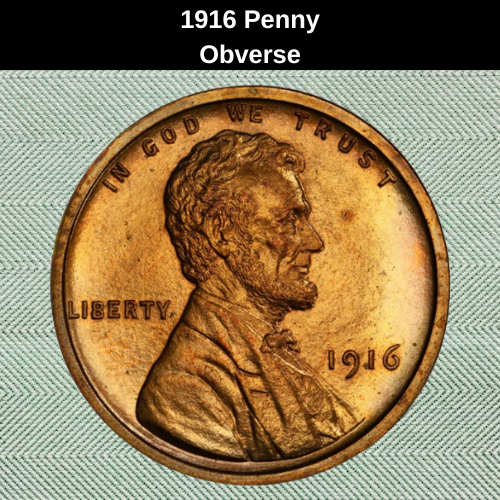
The obverse of every Lincoln penny features a right-facing profile of Abraham Lincoln.
Victor David Brenner, the artist behind the design, aimed to capture Lincoln in a warm and engaging moment. He later explained that he envisioned the president as he might have appeared while reading to a child.
Since Lincoln had long passed by the time Brenner created the portrait, he likely used a photograph taken at Matthew Brady’s studio as his reference.
The coin’s design includes the national motto, “IN GOD WE TRUST,” curving along the upper edge. To the left of Lincoln’s profile is the word “LIBERTY,” while the date is positioned to the right.
If a mint mark is present, it appears just below the date. In 1916, regular-issue pennies were minted in Philadelphia, Denver, and San Francisco, while proof pennies were produced in Philadelphia as well.
During that era, the Philadelphia Mint did not use a mint mark. However, pennies struck in Denver bear a “D,” while those from San Francisco are marked with an “S.”
The Reverse of the 1916 Penny
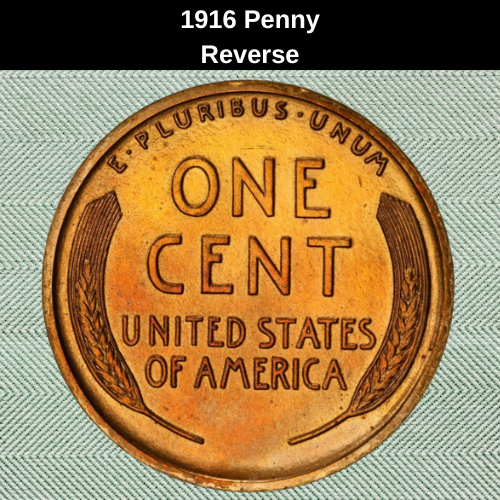
The reverse side of the 1916 penny features a straightforward yet iconic design with two stylized wheat ears. These curve along both edges of the coin, elegantly framing the denomination, which is prominently displayed in the center.
At the top, following the coin’s upper edge, is the Latin phrase “E PLURIBUS UNUM.” This translates to “From the many, one” and symbolizes the formation of the United States as a unified nation of individual states.
Below the denomination, in smaller lettering, is the name of the country, completing the design’s balanced and symmetrical layout.
Other Features of the 1916 Penny
The 1916 penny is composed of bronze, consisting of 95% copper and 5% tin and zinc. Due to its high copper content, the coin’s appearance varies from a bright red hue to a deeper brown tone, depending on its exposure to air and handling.
Coins that have remained well-preserved retain a vibrant red color, similar to newly minted copper. In contrast, those that have circulated more extensively or been exposed to oxidation take on a duller brown shade.
Collectors generally prefer red coins over brown ones, and professional grading services use strict guidelines to categorize them based on color.
A coin is classified as “red” if at least 95% of its surface maintains a red hue. If the red coloration covers between 5% and 95% of the surface, it is labeled “red and brown.” Finally, if less than 5% of the surface remains red, the coin is graded as “brown.”
For a more detailed explanation of Lincoln penny color grading, you can check out educational videos from numismatic experts like CoinOpp on YouTube.
1916 Penny Grading
Coins are graded based on their condition, which significantly impacts their value. Below is the standard grading scale used in numismatics:
| Grade | Description |
|---|---|
| 1 | Basal State – Extremely worn, with barely any visible details. |
| 2 | Fair – Heavy wear, but some design elements are still recognizable. |
| 3 | Very Fair – More details visible but still highly worn. |
| 4, 5, 6 | Good – Basic design is visible, but most fine details are lost. |
| 7, 8, 10 | Very Good – Some major design features remain, though worn. |
| 12, 15 | Fine – Moderate wear with distinct but softened details. |
| 20, 30 | Very Fine – Light wear, with most details still visible. |
| 40 | Extremely Fine – Minimal wear, only affecting high points. |
| 50 | About Uncirculated – Slight traces of wear on the highest points. |
| 60, 65, 70 | Mint State – No wear, ranging from average (MS60) to perfect condition (MS70). |
To accurately determine your coin’s grade and value, refer to detailed grading guides or consult a professional numismatist.
1916 Penny Value Guides
1916 No Mint Mark Penny Value
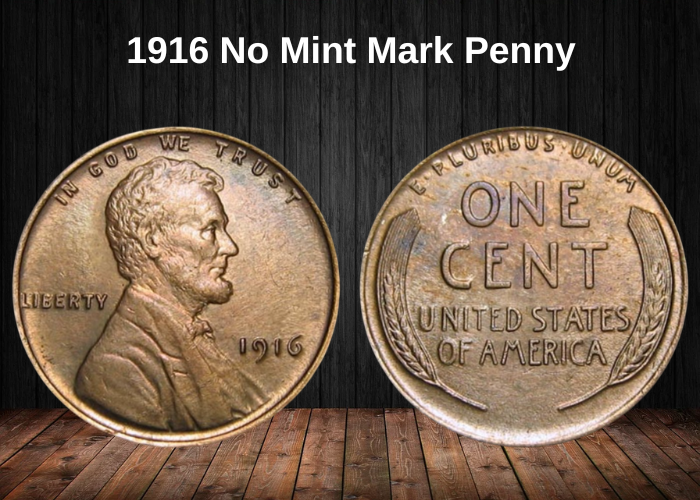
1916 Philadelphia Penny Production and Value
The Philadelphia Mint struck nearly 132 million pennies in 1916. If your coin lacks a mint mark, it was minted in Philadelphia. However, it could be either a regular business strike penny or a proof coin.
Proof coins are made using specially prepared planchets and feature sharper details. They were minted in much smaller numbers and generally hold higher values than regular strikes.
Value of a 1916 No Mint Mark Penny
The condition and color of your coin determine its value. Coins are graded on a 1 to 70 scale, with 1 being the most worn but still identifiable, and 70 representing a flawless example.
Most surviving 1916 (P) business strike pennies are circulated brown coins, typically valued modestly unless they have a Mint error.
Estimated Values by Condition:
- XF45 (Extremely Fine) – Brown: $10
- MS60 (Mint State) – Brown: $30, Red & Brown: $30, Red: $36
- MS65 (Gem Quality) – Brown: $165, Red & Brown: $240, Red: $375
- MS68 (Highest Certified by PCGS) – Estimated value: $62,500
Mint state (uncirculated) coins are significantly more valuable than circulated ones, with red-colored examples commanding the highest premiums.
1916 D Penny Value
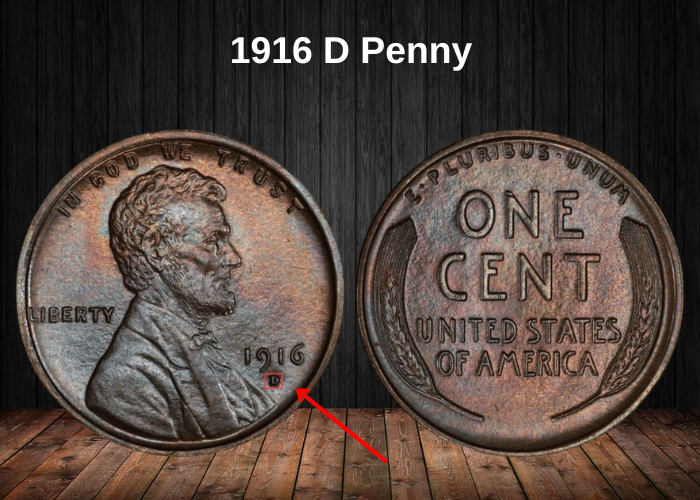
The 1916 D penny, with its mint mark from the Denver Mint, is rarer than the Philadelphia (P) version. Fewer than 36 million were minted, and it’s estimated that only about one in ten of those coins survive today. The number of red 1916 D pennies is especially limited, with only around a thousand thought to still exist.
Estimated Values by Condition for 1916 D Pennies:
- XF45 (Extremely Fine) – Brown: $35 (significantly higher than the Philadelphia equivalent)
- MS60 (Mint State) – Brown: $95, Red and Brown: $100
- MS65 (Gem Quality) – Brown: $475
- MS66 (Gem Quality) – Red and Brown: $2,500
- MS67 (Highest Certified for Red Coins) – Red: $60,000 (there are only three coins at this grade)
The finest known brown example of the 1916 D penny is graded MS67 and is valued at $10,000, showing how much rarer these are in superior conditions compared to the Philadelphia versions.
1916 S Penny Value
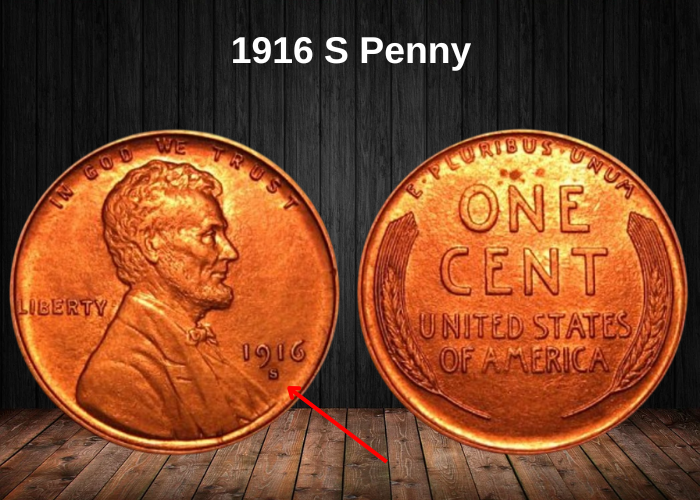
The 1916 S penny has the lowest mintage of the three locations, with only 22.5 million coins struck at the San Francisco Mint. As such, these pennies are rarer and have higher values compared to their Philadelphia and Denver counterparts.
Estimated Values by Condition for 1916 S Pennies:
- XF45 (Extremely Fine) – Brown: $37.5
- MS60 (Mint State) – Brown: $110, Red: $150
- MS65 (Gem Quality) – Brown: $850, Red: $8,500
- MS65+ (Finest Red Certified by PCGS) – Red: $18,000
The finest red 1916 S penny certified by PCGS is graded MS65+, valued at $18,000. Meanwhile, NGC has certified a few coins at MS66, with the last one sold at auction for $3,450 in 1998.
These coins’ value increases significantly as their condition improves, particularly for red examples in gem quality.
1916 (P) No Mint Mark Proof Penny Value
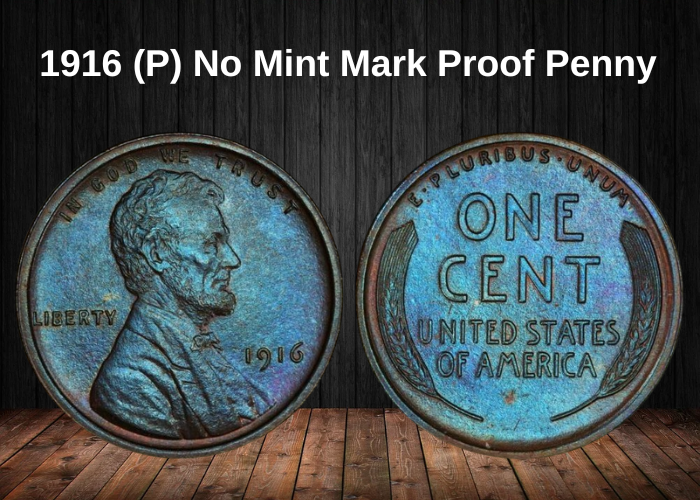
The 1916 proof penny has a very low mintage of only 1,050 coins, making it a highly sought-after item among collectors. Proof coins are struck with higher quality than business strikes, which is reflected in their values. However, no cameo or deep cameo proofs have been found among these pennies.
Estimated Values by Condition for 1916 Proof Pennies:
- AU58 (About Uncirculated) – Brown: $700
- MS61 (Mint State) – Brown: $1,000+
- MS65 (Gem Quality) – Brown: $4,250
- MS67 (Finest Brown) – Brown: $11,000
- MS60 (Red and Brown) – Red and Brown: $925
- MS67+ (Finest Red and Brown) – Red and Brown: $43,500
- MS60 (Red) – Red: $950
- MS66 (Finest Red) – Red: $26,500
- MS67 (Finest Red, NGC) – Red: $34,500 (last sold in 2011)
Rare 1916 Penny Errors List
1916 (P) No Mint Mark Penny, Obverse Lamination
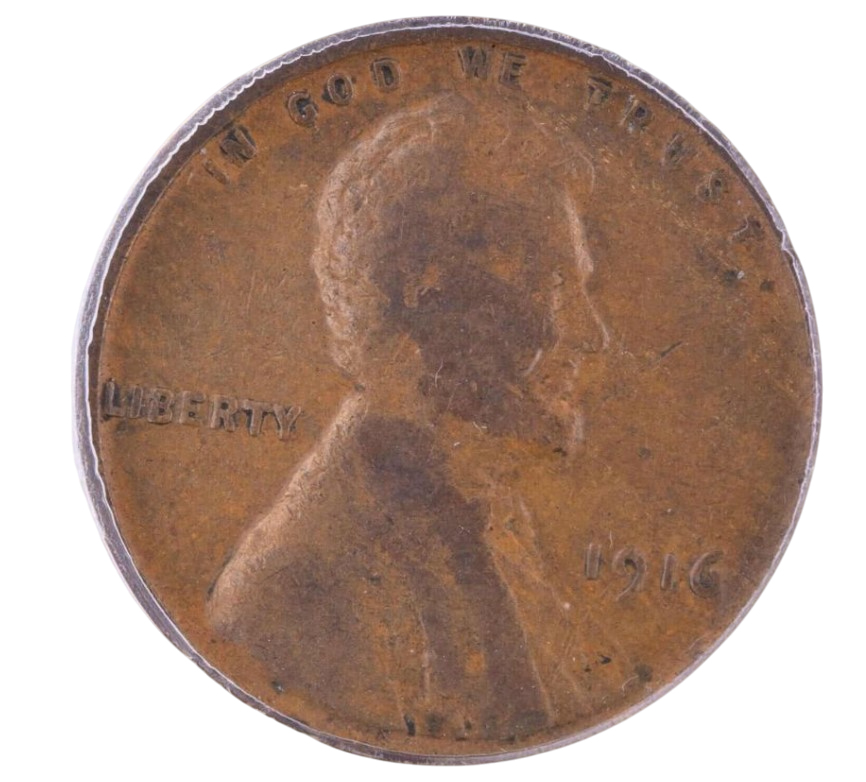
A lamination error occurs when there’s a defect in the composition of the planchet, causing a layer of metal to peel away. This is different from regular wear or damage, but it can sometimes be tricky to distinguish from post-mint damage.
If you’re considering paying a premium for a 1916 penny with a lamination error, it’s wise to ensure the coin has been authenticated by a reputable grading agency like PCGS or NGC to avoid confusion with damage caused by handling.
Example of a Lamination Error on a 1916 Penny:
- Coin: 1916 penny struck in Philadelphia
- Error: Lamination visible on Lincoln’s head and neck
- Grade: MS66 Red (excellent condition)
- Auction Sale: Sold for $150 in 2005
A lamination error, particularly on a high-grade coin like this, can add significant value, as it is considered a unique and collectible flaw.
1916 Penny, Double Die Obverse
Double die errors occur when there is movement during the design transfer from the hub to the die, causing double lines to appear in parts of the design. This defect is transferred to the coins struck by the faulty die, creating an error coin.
However, error coins like double dies are relatively rare among 1916 pennies. While some coins may be marketed as having these types of errors, it’s important to approach them with caution. Some dealers may attempt to pass off damaged or doctored coins as legitimate mint errors.
PCGS and Double Die Errors:
- The PCGS (Professional Coin Grading Service) does not recognize any double die errors in 1916 pennies, regardless of mint mark.
- Despite this, some 1916 pennies with alleged double die obverses or reverses are still being offered for sale.
If you’re interested in purchasing one of these coins, it’s essential to verify its authenticity through a trusted grading service to ensure that it is not just a damaged coin being passed off as a valuable error.
Where to sell your penny?
Now that you know the value of your penny, you might be wondering where to sell it. Don’t worry: here’s a guide to some of the best online platforms where you can easily sell your coins, along with their advantages and disadvantages.
Discover the best platforms for selling coins online (pros and cons).
FAQs about the 1916 Penny
How much is a 1916 penny worth today?
The value of a 1916 penny depends on several factors such as its color, condition, mint mark, and whether it has any Mint errors.
- Poor condition coins can typically be worth only a few dollars.
- Red coins in mint condition can fetch anywhere from hundreds to thousands of dollars.
- The finest examples of 1916 pennies are worth over $60,000.
How rare is a penny from 1916?
- 1916 pennies struck in Philadelphia are relatively easy to find, especially in circulated condition.
- 1916 pennies from Denver (D) and San Francisco (S) are rarer. Look for the “D” or “S” mint mark under the date.
- Proof pennies are much rarer. These coins, like those struck in Philadelphia, don’t have a mint mark but can be identified by the detail of the design. Proofs were produced in far smaller numbers than regular strikes.



















































